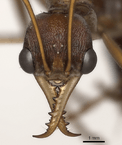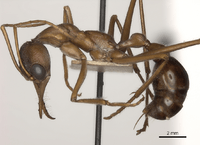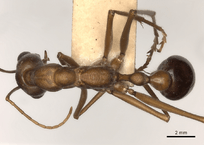Black-headed bull ant facts for kids
Quick facts for kids Myrmecia nigriceps |
|
|---|---|
 |
|
| M. nigriceps worker from Strangways, Victoria | |
| Scientific classification | |
| Kingdom: | |
| Phylum: | |
| Class: | |
| Order: | |
| Family: | |
| Subfamily: |
Myrmeciinae
|
| Genus: | |
| Species: |
M. nigriceps
|
| Binomial name | |
| Myrmecia nigriceps Mayr, 1862
|
|
| Synonyms | |
|
|
The Myrmecia nigriceps, also called the black-headed bull ant, is a type of ant found only in Australia. It belongs to a group of ants called Myrmecia. An Austrian scientist named Gustav Mayr first described this ant in 1862.
These ants are quite large. Worker ants can be from 19 to 23 millimeters (about 0.75 to 0.9 inches) long. However, some workers in a colony are much smaller, sometimes half the usual size. Queens are the biggest ants in the colony, while males are the smallest. You can easily spot males because they have tiny jaws.
Black-headed bull ants are mostly active at night. They live in hot, hilly areas and woodlands. Their nests are built underground in mounds. These ants eat sweet liquids from flowers. They also hunt other small creatures to feed their young. Spiders and echidnas sometimes eat these ants. Like other bull ants, M. nigriceps has a strong and painful sting. Their venom can cause allergic reactions in some people.
Contents
What is the Black-Headed Bull Ant?
How Was This Ant Discovered?
The black-headed bull ant, M. nigriceps, was first identified by Gustav Mayr in 1862. He wrote about it in his science journal. Mayr described the ant based on samples collected in Gayndah and Sydney, Australia.
Later, in 1907, another scientist thought M. nigriceps was just a different version of another ant, M. vindex. But in 1933, an American scientist, William Morton Wheeler, said it was its own species again. He noticed it was found all over Australia and was generally bigger than M. vindex. Another scientist, John S. Clark, also named a similar ant, Myrmecia fasciata. But this is now considered the same as M. nigriceps.
What Does Its Name Mean?
The name nigriceps comes from two Latin words. Niger means "black," and caput means "head." This name perfectly describes the ant's distinct black head. That's why it's commonly known as the black-headed bull ant.
What Do Black-Headed Bull Ants Look Like?
Worker ants are usually between 19 and 23 millimeters long. But some colonies have very small workers, less than half that size. We don't know if this means they are polymorphic (meaning they have different body forms). This is because their body shapes don't change much, unlike some other ant species.
Queens are the largest ants, measuring about 24 to 26 millimeters. Males are smaller, around 18 to 20 millimeters, similar to worker ants. The head and the main body part (gaster) of the ant are black. Their middle body part (thorax) and other sections are red or yellowish-red. Their feelers (antennae) and legs are yellow. Their jaws (mandibles) and a part of their face (clypeus) are also yellow.
These ants have short, yellow hairs on their bodies and legs. They also have fine, white, soft hairs all over their gaster. The head is almost as wide as it is long. Their mandibles are longer than their head and have 13 teeth.
Differences Between Ants in a Colony
The queen looks a lot like a worker ant, but she is bigger. She has more hair and a wider head. Her mandibles are shorter and wider, but still as long as her head. Her wings are yellowish and see-through.
Males are the smallest ants in the colony. You can easily tell them apart by their much smaller mandibles. Males have the longest and most hair compared to workers and queens. They also have a long and wide head.
M. nigriceps looks similar to M. vindex. However, M. nigriceps is usually larger. Its head is black or dark brown and is wider and more rectangular in workers. The thorax and pedicel (a narrow waist part) are darker and brownish-red. Despite these differences, their nests and behaviors are quite similar.
Where Do Black-Headed Bull Ants Live?
M. nigriceps ants are found all over Australia. They are not found in central Australia or along the northern coast. You can find them in Queensland, New South Wales, the Australian Capital Territory, Victoria, South Australia, and Western Australia.
They live in many places, including deserts, coastal areas, plateaus, woodlands, and hot, hilly areas with scrubby plants. They can be found at heights from 300 to 460 meters (about 1,000 to 1,500 feet) above sea level.
Their Nests
These ants build mounds for their nests. Sometimes, colonies can also be found under logs. Workers decorate their nests with small items like pebbles and soil crumbs. This is similar to how meat ants (Iridomyrmex purpureus) decorate their nests. They also use small stones and plant material for decoration.
How Do Black-Headed Bull Ants Behave?
Black-headed bull ants are active during twilight and at night. They search for food when the sun is setting or after dark. Workers often look for food on Eucalyptus trees.
Adult ants drink sweet liquids from plants. The young ants (larvae) are meat-eaters. They eat small creatures like insects and other ants. Some cockroaches can defend themselves from M. nigriceps attacks. They release a special liquid that confuses the ants. Workers start looking for food about an hour before sunset. They are most active during twilight.
Amazing Vision
These ants have excellent eyesight. They have the largest eye lenses and light-sensing cells of any Myrmecia ant. They can tell how far away objects are and how big they are, even if they are almost a meter away. They are very good at sensing movement. If something moves, they will quickly charge towards it to attack.
Who Eats These Ants?
The short-beaked echidna (Tachyglossus aculeatus) eats these ants. Spiders in the genus Zenodorus, especially Zenodorus metallescens, also hunt them. Blindsnakes are known to eat the young ants (larvae and pupae). Sometimes, another ant species, M. inquilina, lives in their colonies. This ant is a social parasite that lays its eggs inside the M. nigriceps colony.
Their Sting
M. nigriceps ants are very aggressive. Large colonies can be very fierce, even against other Myrmecia species. While their mandibles (jaws) don't cause much pain to humans, their sting is very painful and powerful. The sting is at the end of their gaster. Unlike bees, their sting is not barbed, so they can sting many times without hurting themselves.
The venom of M. nigriceps is not as strong as some other Myrmecia ants. However, some people can have an allergic reaction to it. In a study from 2011, at least one person had a serious allergic reaction. This study also showed that many other Myrmecia species can cause anaphylaxis, a severe allergic reaction. On a scale that compares the pain of insect stings, the M. nigriceps sting was rated as "painful."
Interestingly, M. nigriceps ants can enter colonies that are not their own without being attacked. This might be because they don't recognize ants from other colonies as enemies. Or, perhaps, there isn't much risk in ignoring them.
Life Cycle and Mating
Mating flights happen after several days of rain, usually between summer and mid-autumn (December to March). The male ants and new queens fly out of their nest. Unlike some other ants that mate on the ground, these ants fly directly from the nest. Mating flights are often seen on hilltops.
M. nigriceps queens do not seal their nest entrance when they start a new colony. This is different from some other Myrmecia species. Worker ants can live for a very long time, usually around 2.2 years. Some workers can live for up to 2.4 years!
See also
 In Spanish: Myrmecia nigriceps para niños
In Spanish: Myrmecia nigriceps para niños





